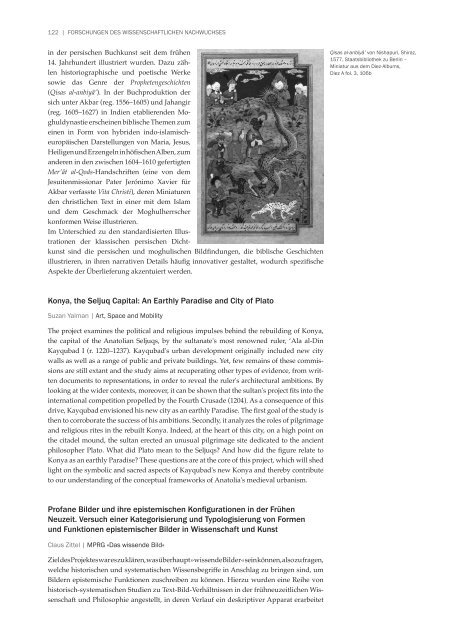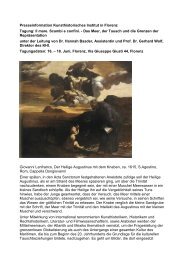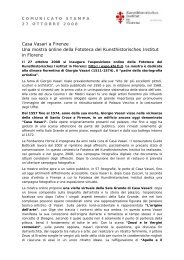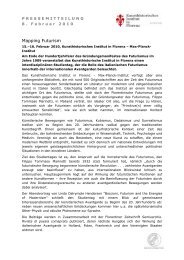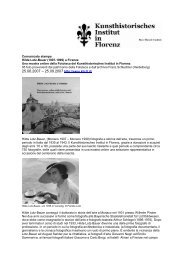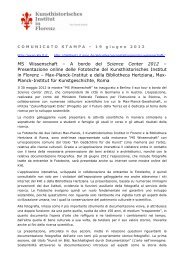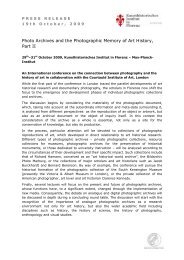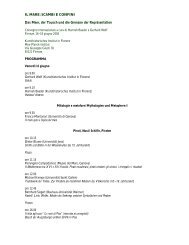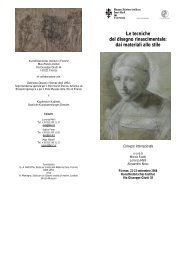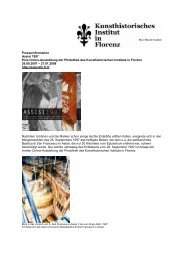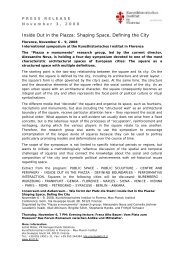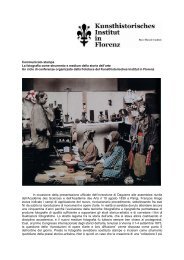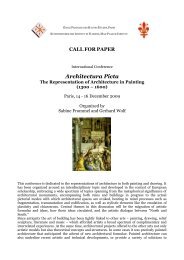forschungsbericht november 2008 – juli 2012 - Kunsthistorisches ...
forschungsbericht november 2008 – juli 2012 - Kunsthistorisches ...
forschungsbericht november 2008 – juli 2012 - Kunsthistorisches ...
Erfolgreiche ePaper selbst erstellen
Machen Sie aus Ihren PDF Publikationen ein blätterbares Flipbook mit unserer einzigartigen Google optimierten e-Paper Software.
122 | FORSCHUNGEN DES WISSENSCHAFTLICHEN NACHWUCHSES<br />
in der persischen Buchkunst seit dem frühen<br />
14. Jahrhundert illustriert wurden. Dazu zählen<br />
historiographische und poetische Werke<br />
sowie das Genre der Prophetengeschichten<br />
(Qisas al-anbiyâ’). In der Buchproduktion der<br />
sich unter Akbar (reg. 1556<strong>–</strong>1605) und Jahangir<br />
(reg. 1605<strong>–</strong>1627) in Indien etablierenden Moghuldynastie<br />
erscheinen biblische Themen zum<br />
einen in Form von hybriden indo-islamischeuropäischen<br />
Darstellungen von Maria, Jesus,<br />
Heiligen und Erzengeln in höfischen Alben, zum<br />
anderen in den zwischen 1604<strong>–</strong>1610 gefertigten<br />
Mer’ât al-Qods-Handschriften (eine von dem<br />
Jesuitenmissionar Pater Jerónimo Xavier für<br />
Akbar verfasste Vita Christi), deren Miniaturen<br />
den christlichen Text in einer mit dem Islam<br />
und dem Geschmack der Moghulherrscher<br />
konformen Weise illustrieren.<br />
Im Unterschied zu den standardisierten Illustrationen<br />
der klassischen persischen Dichtkunst<br />
sind die persischen und moghulischen Bildfindungen, die biblische Geschichten<br />
illustrieren, in ihren narrativen Details häufig innovativer gestaltet, wodurch spezifische<br />
Aspekte der Überlieferung akzentuiert werden.<br />
Qisas al-anbiyâ’ von Nishapuri, Shiraz,<br />
1577, Staatsbibliothek zu Berlin <strong>–</strong><br />
Miniatur aus dem Diez-Albums,<br />
Diez A fol. 3, 106b<br />
Konya, the Seljuq Capital: An Earthly Paradise and City of Plato<br />
Suzan Yalman | Art, Space and Mobility<br />
The project examines the political and religious impulses behind the rebuilding of Konya,<br />
the capital of the Anatolian Seljuqs, by the sultanate's most renowned ruler, ‘Ala al-Din<br />
Kayqubad I (r. 1220<strong>–</strong>1237). Kayqubad's urban development originally included new city<br />
walls as well as a range of public and private buildings. Yet, few remains of these commissions<br />
are still extant and the study aims at recuperating other types of evidence, from written<br />
documents to representations, in order to reveal the ruler's architectural ambitions. By<br />
looking at the wider contexts, moreover, it can be shown that the sultan's project fits into the<br />
international competition propelled by the Fourth Crusade (1204). As a consequence of this<br />
drive, Kayqubad envisioned his new city as an earthly Paradise. The first goal of the study is<br />
then to corroborate the success of his ambitions. Secondly, it analyzes the roles of pilgrimage<br />
and religious rites in the rebuilt Konya. Indeed, at the heart of this city, on a high point on<br />
the citadel mound, the sultan erected an unusual pilgrimage site dedicated to the ancient<br />
philosopher Plato. What did Plato mean to the Seljuqs? And how did the figure relate to<br />
Konya as an earthly Paradise? These questions are at the core of this project, which will shed<br />
light on the symbolic and sacred aspects of Kayqubad's new Konya and thereby contribute<br />
to our understanding of the conceptual frameworks of Anatolia's medieval urbanism.<br />
Profane Bilder und ihre epistemischen Konfigurationen in der Frühen<br />
Neuzeit. Versuch einer Kategorisierung und Typologisierung von Formen<br />
und Funktionen epistemischer Bilder in Wissenschaft und Kunst<br />
Claus Zittel | MPRG »Das wissende Bild«<br />
Ziel des Projektes war es zu klären, was überhaupt »wissende Bilder« sein können, also zu fragen,<br />
welche historischen und systematischen Wissensbegriffe in Anschlag zu bringen sind, um<br />
Bildern epistemische Funktionen zuschreiben zu können. Hierzu wurden eine Reihe von<br />
historisch-systematischen Studien zu Text-Bild-Verhältnissen in der frühneuzeitlichen Wissenschaft<br />
und Philosophie angestellt, in deren Verlauf ein deskriptiver Apparat erarbeitet


